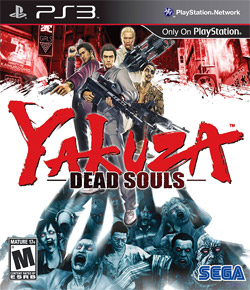Summary
Shun Akiyama and his secretary Hana witness a zombified figure attacking yakuza of the Tojo Clan. With the assistance of Tojo Clan member Tomoaki Nagahama, Akiyama and Hana are able to return to their office. Later, Hana falls ill while their office is overrun by zombies, so Akiyama moves her to the New Serena bar. While looking for medicine for Hana, Akiyama sees several massive barricades planted all over Kamurocho by the Japanese Self-Defense Force (SDF) in order to contain the outbreak. After getting the medicine for Hana and parting ways with Nagahama, Akiyama returns to find Hana gone and New Serena overrun. He receives a message from her that she moved to an abandoned hotel; Akiyama reunites with her and saves her from a powerful mutant known as the "Prototype". Akiyama manages to kill it, and discovers that the prototype was manufactured by someone who may also know about the outbreak in Kamurocho.
Meanwhile, Goro Majima's headquarters are attacked by the zombies, but a combat-enthusiastic Majima easily dispatches them. Majima heads to Kamurocho Hills to help escaping citizens and to locate the remaining Tojo Clan members. With help from Tojo chairman Daigo Dojima, Majima is able to assist the survivors, but is bitten by a zombie in the process. At Purgatory, a gambling den, an information broker known as "The Florist" suggests to Daigo and Majima that the Omi Alliance might be responsible for Kamurocho's outbreak, as the initial attack was against the Tojo Clan, and former member Ryuji Goda and top officer Tetsuo Nikaido were seen in Kamurocho before the outbreak started. Akiyama and Majima go to the batting cage where they encounter Nikaido and an unknown accomplice of his, who admit to being behind the outbreak; Nikaido declares that he wants to avenge Ryuji's defeat at the hands of Kiryu, despite Ryuji's disapproval. Nikaido then summons another prototype mutant, but it is eventually killed due to the sudden arrival of Ryuji.
A flashback reveals that after Ryuji's expulsion from the Omi Alliance, he started a new life working at a takoyaki stand under the mentorship of a veteran chef called Pops. One day, Nikaido urged him to return to the alliance, but Ryuji refused and insisted that he has no intention of getting revenge on Kiryu. In the present, Ryuji goes to a night club to confront Nikaido; when Ryuji once again refuses to take part in his vendetta against Kiryu, Nikaido releases another prototype which is revealed to be a mutated Pops, and a dejected Ryuji is forced to kill him before swearing vengeance on Nikaido.
In Okinawa, Kazuma Kiryu receives a mysterious phone call from someone who claims to have kidnapped Haruka; the caller demands Kiryu return to Kamurocho if he wants to see Haruka again. Kiryu arrives in Kamurocho and meets SDF soldier Misuzu Asagi. After killing the zombified Nagahama, the two head to Kamurocho Hills to look for Asagi's comrades, but they have already been zombified by the mutant which attacked the Tojo earlier: Hiroshi Hayashi, former Omi Alliance officer and an old rival of Kiryu. After killing the zombified soldiers, Kiryu and Asagi meet Majima, who tells them that survivors are taking refuge in Purgatory. Majima then leaves them both, not wanting to endanger them if he turns, and to find a cure for his infection. Kiryu also recalls the flashback where he received the mail meant for Haruka's new career at Kamurocho, before he learned too late that the mail was a set up by Nikaido to kidnap her, in order to lure Kiryu into his trap via zombie outbreak.
The Florist and Akiyama inform Kiryu that Nikaido's accomplice is an arms dealer named "DD", who started the outbreak with Thanatos, a bioweapon of DD's creation. Kiryu and Ryuji then storm the Millennium Tower to save Haruka and defeat Nikaido. Along the way, they defeat Hayashi, who reveals that he was made into a mutant after refusing Nikaido and DD's plan to destroy the Tojo Clan before dying. They continue to fight through Nikaido and DD's remaining prototypes and witness DD turn Nikaido into a mutant. Kiryu and Ryuji defeat Nikaido, but he further mutates into a towering beast; after Kiryu defeats him a final time with the help of Asagi, DD tries to escape in a helicopter which is piloted by Akiyama; he jumps to safety before letting the helicopter and DD crash into the zombies below.
The next morning, the SDF has eliminated the remaining zombies and ended the outbreak. Majima is revealed to be well, as the zombie that bit him had dentures, and his fever was simply due to his pollen allergy. Some time later, everyone returns to their old lives; Akiyama and Hana resume their moneylending business, Majima continues to supervise Kamurocho Hills, Ryuji now runs the takoyaki stand in Pops' place, and Kiryu and Haruka return to Okinawa once more.
In a post-credits scene, the police and SDF have a tense standoff with a supposed zombie, but he is revealed to simply be a drunken man.


